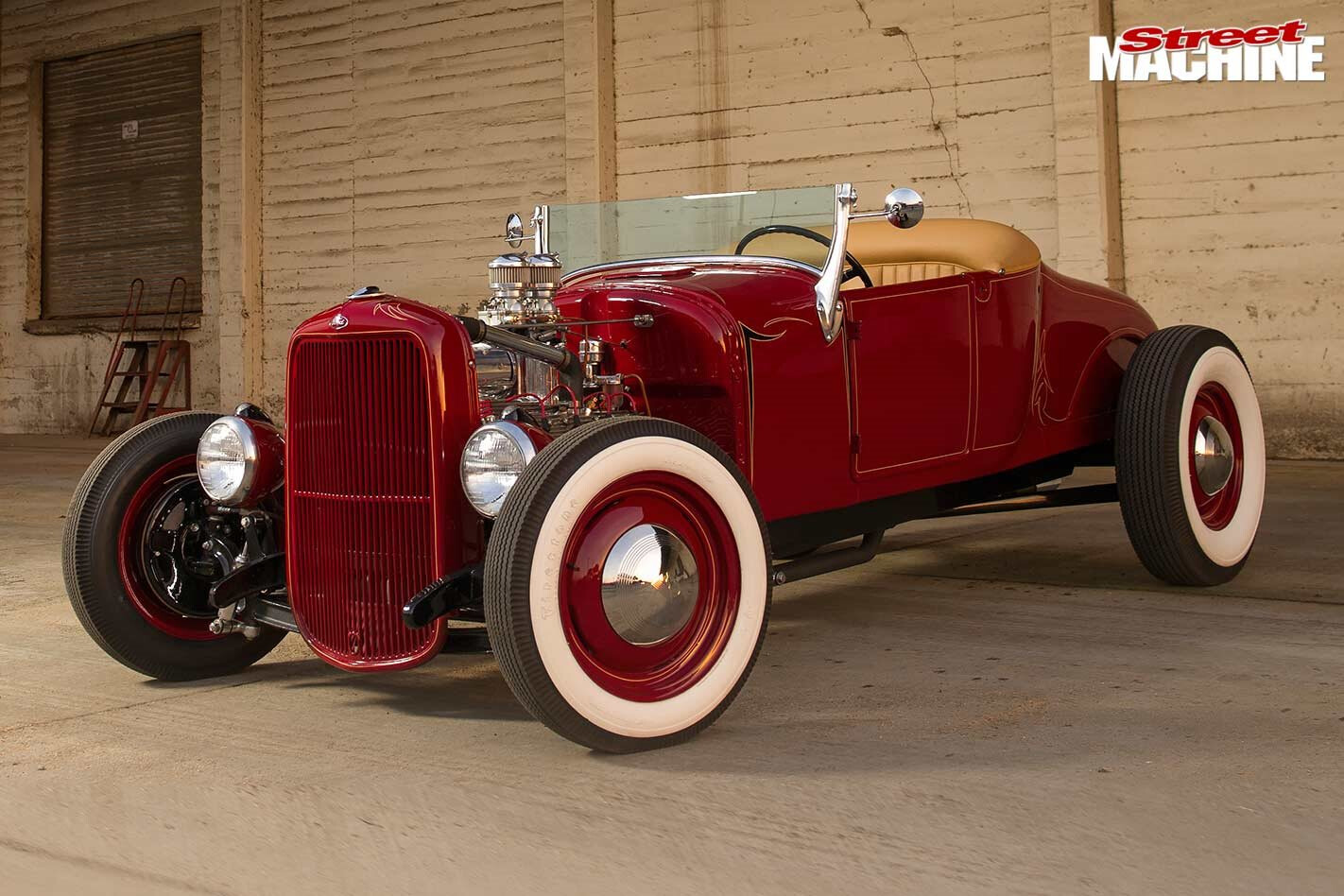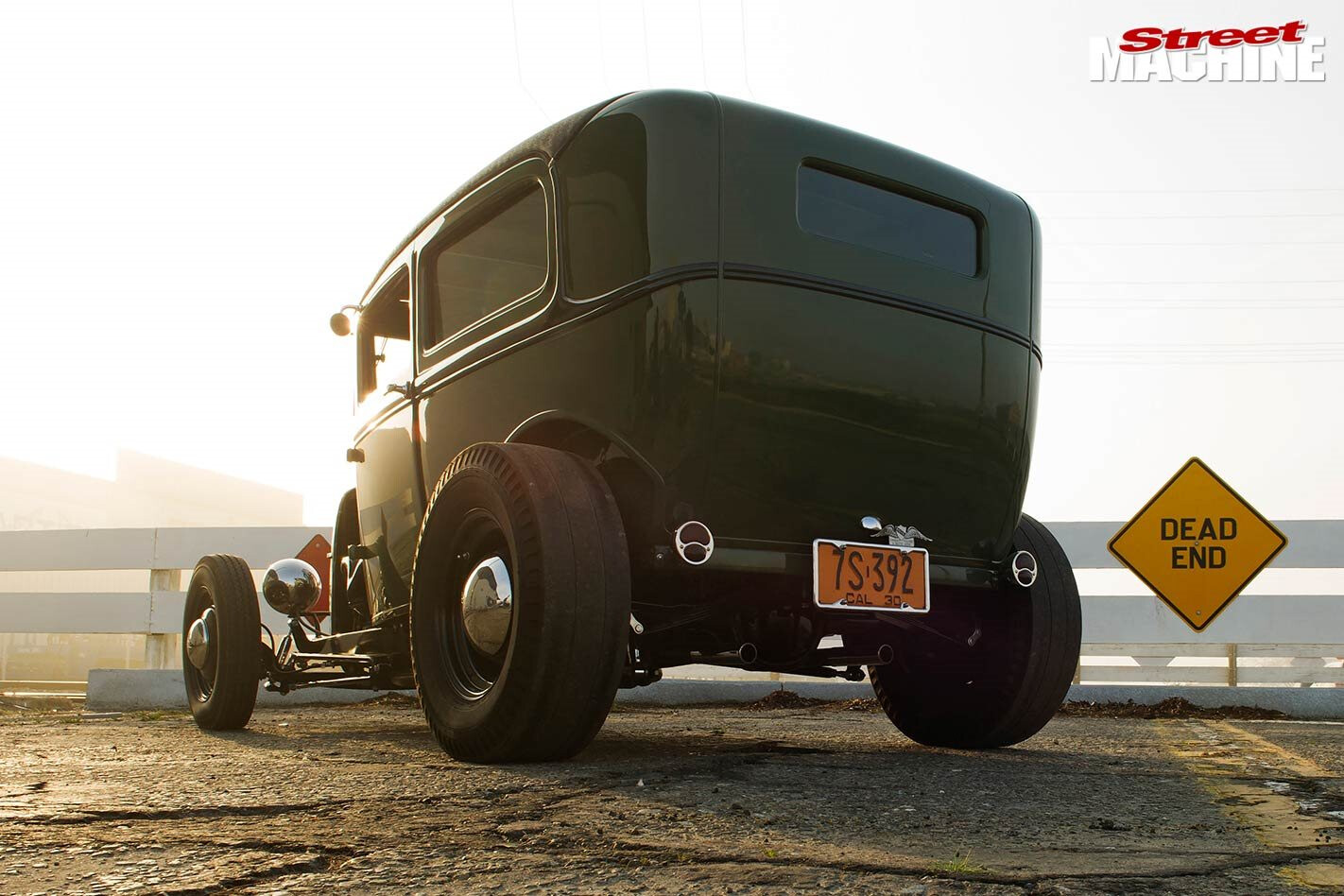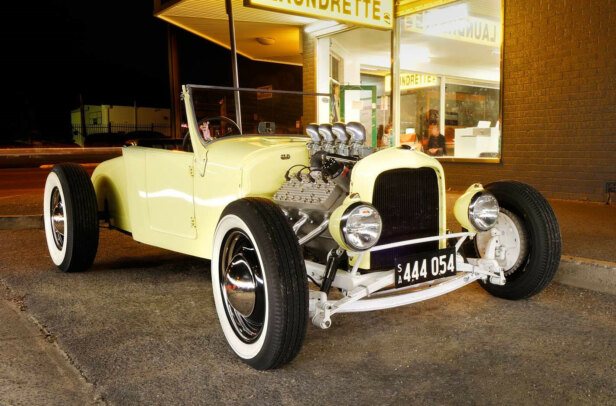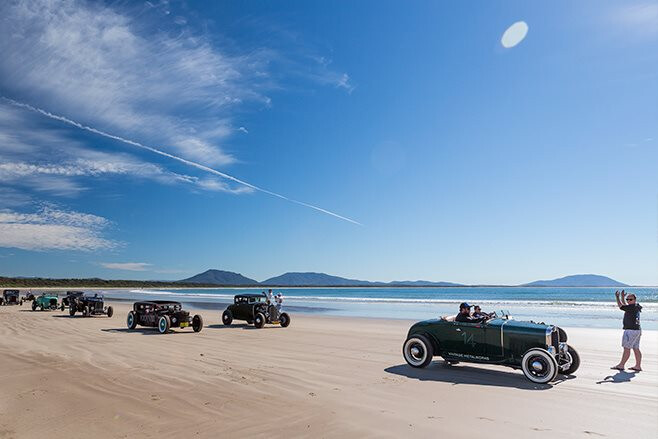THERE are two heroes in this tale: a neat little flathead-powered T roadster, and the California hot rodder who built it. You might know the name Tim McMaster from our Bonneville coverage over the years, as we usually run a shot of his ’62 F100 unibody. Or maybe you know him from the HAMB as ‘mctim64’, the Y-block guy. If you haven’t heard of Tim yet, then you’re about learn a lot about his cars, the origins of his Y-block fetish, and the business he’s been working at for the past 33 years, Hanford Auto Supply.
This article was first published in Street Machine’s Hot Rod magazine, issue #19
It’s not super-low, but the Boling Brothers chassis has a 2in kick-up in the front. The 4.50- and 7.00-16 tyres help give it a bit of rubber rake too
The desire to build the T roadster came about after Tim had sold a previous open-topped car he’d owned – a ’73 Triumph TR6. You may wonder what a red-blooded American rodder and racer was doing with an English sports car in the first place, but it’s an affliction that has been with him for a long time.
“My second car was the MGB GT that I’ve had since I was 16; I was really into them,” Tim confesses.
His first car was a 1960 F100, which he saw for sale by the roadside as he was driving home from the DMV having just got his licence on his 16th birthday. He paid $500 and received an introduction to F100 fridges (1957-60) and Y-block engines.
“They were the red-headed stepchild of F100s; everyone wanted the ’53-’56 models,” says Tim.
While that was a pretty early introduction to the Y-block, Tim jokes that it goes way back to when he was a young farm boy riding to market.
“We actually lived in town but always had this orange farm out in the country that my grandmother started in 1918,” he explains. “My uncle had a ’64 F100 with a Y-block in it and that was one of the first cars I learned to drive in, and he also had a ’60 F600 that he hauled the fruit with.
Yep, that’s a quick-change, but not your regular Halibrand. It’s from a guy in Oregon called Mike Moore, and he only builds three a year
“I always like to tell people that I distinctly remember riding between my uncle and my father going to the packing house with loads of oranges, and the Y-block just kind of seeped into me. I actually had no idea what a Y-block was.”
Something must have happened in those early years, because the plans Tim’s parents had for his future didn’t quite pan out.
“I think I’m a bit of a disappointment to my father because he was an electrical engineer and had me interested in things at a young age. I was doing drafting, was in all the science fairs, even got teased a little bit in the lower grades for being ‘Mr Science’.”
Brakes are big Lincoln drums from MT Car Products on the front and ’41 Lincoln on the rear
He discovered cars at age 15 when he got into auto shop in high school, and, in his own words, “became a motor head and a grease monkey”. Tim’s auto shop teacher, Bob Graff, had worked for Chrysler and had a T-bucket featured in Car Craft magazine in the 60s.
“If you were casting a movie in the 1950s and wanted an auto shop teacher, he was that guy,” says Tim. “He was a flathead guy before he was a Hemi guy, so he got me interested in flatheads.”
While that interest took decades to manifest itself in a build, once Tim got started on the roadster, it didn’t take all that long to complete.
The 59AB block has been punched out and stroked for a total of 276 cubes. Tim tweaked the heads, milling about 120thou off them to bring the compression up to 9.0:1
“A friend of mine, Eric Hibbs from Utah, brought the body up to me at the Grand National in 2014,” he says. “He had it in the back of his pick-up but he didn’t want to leave it there and get it stolen, so he put it in his hotel room!
“The chassis is basic Boling Brothers. Derrek Boling and I have quite the relationship going with trade – I build engines for him and he builds chassis for me; that’s a good way to do it.”
One really neat part of the build is the quick-change rear end, but it’s not your usual Halibrand or Winters deal. It was home-built from a banjo out of a 1941 Mercury by a bloke called Mike Moore, whom Tim met on the Bonneville salt.
Tim’s first introduction to salt lake racing was with Charlie Burns and his stepside ’57 F100. Then somebody suggested using a unibody because they’re probably more aerodynamic – if you can make a block of flats more aerodynamic
“I’m real pleased with it,” he says. “It runs really good, makes very little noise – you expect it to whine like crazy – but it’s fairly comfortable to drive.”
Tim initially had a good idea of how he wanted the car to look, but things did evolve over the four-year build period.
These reproduction Stromberg 97s are exactly like the originals; they even leak in the same spots
“I wanted a late-40s, early-50s-style hot rod,” he says. “There are things that you plan in your head and they change along the way; I was going to run spoke wheels on it, but the ’40s, I think, look a lot better on it. I was going to do blackwalls, but doggone it, those whitewalls sure make it pop.”
The flathead was always in the plan. In fact, the engine was around before the car was even a thought. It was just looking for a place to go. Being a machinist and engine builder, Tim gave the old flattie a good going-over.
It took a bit of time, but Tim collected a dash full of gauges, including an S-W survey speedo and 8000rpm tacho. I’m fairly sure the old flathead doesn’t need that rpm range, but she’ll go over 90mph – allegedly
“I did some tweaks to the heads,” he says. “I always check the quench area and the clearances. They make those things kind of sloppy these days, one size fits all, and it had a quench area of 190thou so I took a good 120thou off of it so it would tighten it up and also raise the compression ratio. It works real good; I have no doubt that has something to do with its peppy performance. It’s not a high revver but it revs really quick with a 10lb flywheel on it.”
The cool old 2×2 Thickstun intake was one piece of the puzzle that fell into place nicely for Tim.
The seat has been made to get your bum down as low as possible so that you’re sitting in the car and not on it
“I was specifically looking for a Thickstun, and I was going to be happy with a PM-7, but at the California Hot Rod Reunion swap meet I came across a guy that had this pre-war Thickstun. The stories I’ve heard after the fact is that it’s the kind of manifold Vic Edelbrock ran when he set his records before he was making his own manifolds. It’s just a nice period piece.”
With a few other friends donating parts, Tim was getting all the bits he needed to put together a cool little car, and for him, that’s what it’s all about.
“It’s a typical hot rod,” he says. “You get parts from everybody and they come together and make a car.”
One thing that really didn’t go to plan was the paintjob, but all’s well that ends well.
“The colour was supposed to be the same as the colour of my TR6 that I sold,” explains Tim, “but whoever mixed the paint didn’t do it right and it came out that kind of ruby red, and so what? I like it – everybody seems to like it. It’s not what I was expecting, but it looks good.”
With some pinstriping by Zeke Jaggers to finish it off, it turned out a treat.
INSIDE TIM’S SHOP: HANFORD AUTO SUPPLY
When Tim took over the shop, he had a massive clean-out, scrapping around 17-18 tons of iron, but he kept plenty of useable stuff.
I can vouch that this is the best-sounding engine on the Bonneville salt flats, and it has run 147.195mph with Y-block power.
The orange inline is a 250 Chevy that’s slated for a Camaro. The big-block Chev looks killer with those big injection stacks, and that’s a Y-block in the foreground with a Chevy injection plonked on top.
Tim recently picked up this V8-60 and yes, it runs – I’ve heard it!
Flathead heads look good whether shiny or unpolished (right).
Tim’s new race car is this roadster that has already run over 200mph with SBC power. He wants to run 200mph with a Y-block, and has a bit of a grudge match going with Keith Cornell from the Rolling Bones.
The tractor is just for a bit of a laugh and has had a flathead V8 installed. Tim putts it up and down the street every now and then, but he’s not a tractor guy!
There are a few cool engines on display, including a pinstriped 221 flathead and a Y-block that was a failed experiment of a dragster engine. Tim wanted a short-stroke, big-bore that would just rev forever, but the block cracked.
TIM MCMASTER
1927 FORD MODEL T ROADSTER
Paint: Ruby Red custom mix
DONK
Type: 276ci 1948 Ford 59AB
Inlet: Thickstun pre-war high-rise
Carbs: Twin Big 97s
Heads: Offenhauser 425
Valves: Stainless undercut 1.6in (in), 1.5in (ex)
Pistons: 3.312in bore
Cam: Hot
Crank: Mercury 4in stroke
Radiator: Walker
Exhaust: Modified Speedway headers
Ignition: Stromberg E-Fire distributor
SHIFT
’Box: 1939 Ford with Zephyr gears
Diff: 1941 Mercury with Mike Moore quick-change
BENEATH
Front end: Dropped I-beam
Shocks: Pete & Jake’s chrome (f & r)
Steering: Vega cross-steer
Brakes: MT Car Products Lincoln drums (f), ’41 Lincoln drums (r)
ROLLING STOCK
Rims: 1940 Ford; 16×4 (f), 16×4.5 (r)
Rubber: Coker wide whitewall; 4.50-16 (f), 7.00-16 (r)
THANKS
Derrek Boling of Boling Brothers Early Iron for all the help with the frame and fab work; Eric Hibbs for finding and delivering such a great T body to start with; Mark Skipper for being my hot rod mentor – if he hadn’t let me drive his ’32 coupe survivor long ago, I may not have got the bug or the encouragement to go forward with a lifelong dream to own a ‘real’ hot rod. Maybe I should also thank Ken and Keith of the Rolling Bones for letting me hang out with them so I can meet all these great automotive photographers




Comments